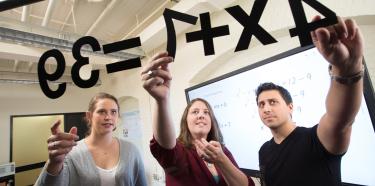Some educators and parents may think of educational games as “sugar coating,” and insist on the rigor of more traditional pencil-and-paper, “show your work” approaches. But Ottmar and her Indiana colleagues David Landy and Erik Weitnauer believe the development of Graspable Math has led to a “better paper,” which captures the power of learning through onscreen manipulation. With its flexibility, their better paper also lets kids discover there is often more than one way to approach and solve a math problem. What’s more, by tapping into different ways of thinking and being creative, the technology may boost confidence and short-circuit the anxiety that too often turns kids off to math at a young age.
Math on Your Wrist
Ivon Arroyo, PhD, also works with the concept of embodiment and learning, transforming traditional children’s games with Wi-Fi connected “wearables” that offer learning challenges and feedback. Her games teach the basics of number sense, measurement estimation, and geometry while letting children run and play in open spaces as they search for objects that match specified mathematical parameters.
In her early work, Arroyo developed e-Textiles—for example, hoodies with attached sensors and LED displays on the sleeves. Children wore them to play a version of hide-and-seek, as they were challenged by constraints such as “Hide behind an object that has a volume of greater than 50 cubic feet.” Some practical problems emerged in testing—the sweatshirts were bulky and unattractive, the wiring was fragile, and teachers wanted to know, “Who’s going to wash these shirts?” Arroyo has advanced the concept with sleeker “learning assistants,” such as smart watches and cell phones anchored to arms with sports holsters.

Ivon Arroyo watches as her son, Nicolás Arroyo
Lisle, tries out the game “Estimate It!” using
clues on the smartphone on his wrist.
The theory of embodied cognition links thinking skills with social, sensory, and motor functions. “It is believed that motor action is encoded within the brain—not just abstract ideas,” Arroyo says. She adds that this is not new—especially at the elementary school level, teachers are already intuitively incorporating touch and motion in learning activities by using hands-on activities that involve the manipulation of concrete objects in the classroom. Her aim is to understand the connections between embodied hands-on activities and learning in a scientific manner, deciphering what are important components of motor action that may be conducive to learning while leveraging the power of lightweight, mobile technology in games that combine learning and fun.
Arroyo’s undergraduate students (working on IQPs and MQPs) have created a new software and hardware infrastructure that supports embodied games. The “Wearable Game Engine” is a Web-based platform that allows teachers and students to play games outside or inside with one mobile device per student, provided there’s a Wi-Fi or cellular connection available. Arroyo’s graduate students have created games that make use of these wearables, such as “Tangrams Race”—a relay race that has students running to fetch puzzle pieces that match specified geocentric constraints, then working as a team to assemble them to fit an intricate pattern (Yuting Liu, MS candidate, IMGD). “Estimate It!” sends students outside to seek objects that fit the specified criteria, equipped with only crude measuring tools, such as a 12-inch dowel (Leigh Rountree, MS candidate, IMGD).
Students can press colored buttons on their watches for cues and hints; they also use the buttons to input sequences of colored dots that appear on target objects, thus indicating they’ve found the correct object. They can also scan the objects using the NFC (near field communication) capability available in cell phones and smartwatches.
Beyond the empirical results Arroyo gathers is thejoy captured in her videos of children engaged in these educational games. She also uses video as a tool in re-cap discussions that can inspire children to review their actions as a group, and reflect on the choices they made during play.


